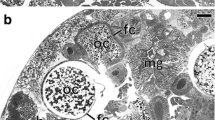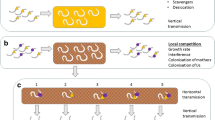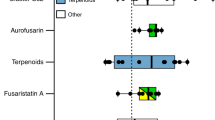Abstract
The role of intracellular symbionts contributing to their host has been investigated in the planthoppers,Nilaparvata lugens Stal andLaodelphax striatellus Fallen. We have found that the isolated yeastlike symbionts, identified as a member of the genusCandida, from the host's egg produce ergosterol when cultured. A comparative study of sterols in the cultured symbionts, the host insects, aposymbiotic host insects, and dietary plants demonstrated that ergosterol produced in the symbiotes is provided to the host insects and possibly transformed in the host insects into cholesterol via 24-methylenecholesterol. The conversion of injected 24-methylenecholesterol-d3 into cholesterol has been shown in the brown planthopper (N. lugens).
Similar content being viewed by others
References
Campbell, B.C., andNes, W.D. 1983. A reappraisal of sterol biosynthesis and metabolism in aphids.J. Insect Physiol. 29:149–156.
Clayton, R.B. 1964. The utilization of sterols by insects.J. Lipid Res. 5:3–19.
Ehrhardt, P. 1968. Nachweis einer durch symbiontische Microorganismen bewirkten Sterinsynthese in kunstlich ernährten Aphiden (Homoptera, Phynchota, Insecta).Experimentia 24:82–83.
Fredenhagen, A., Kenny, P.T.M., Kita, H., Komura, H., Naya, Y., Nakanishi, K. Nishiyama, K., Sugiura, M., andTamura, S.Y. 1987a. Role of intracellular symbiotes in planthoppers, pp. 101–108,in R. Greenhalgh and T.R. Roberts (eds.). Pesticide Science and Biotechnology; 6th IUPAC Congress of Pesticide Chemistry. Blackwell Scientific Publ., London.
Fredenhagen, A., Tamura, S.Y., Kenny, P.T.M., Komura, H., Naya, Y., Nakanishi, K., Nishiyama, K., Sugiura, M. andKita, H. 1987b. Andrimid, a new peptide antibiotic produced by an intracellular bacterial symbiont isolated from a brown planthopper.J. Am. Chem. Soc. 109:4409–4411.
Griffiths, G.W., andBeck, S.D. 1975. Ultrastructure of pea aphids mycetocytes: Evidence for symbiote secretion.Cell Tissue Res. 159:351–367.
Hinde, R. 1971. The control of the mycetome symbiotes of the aphidsBrevicoryne brassicae, Myzus persicae, andMacrosiphum rosae.J. Insect Physiol. 17:1791–1800.
Houk, E.J., Griffiths, G.W., andBeck, S.D. 1976. Lipid metabolism in the symbiotes of the pea aphid,Acyrthosiphon pisum.Comp. Biochem. Physiol. 54B:427–431.
Kusumi, T., Suwa, T., Kita, H., andNasu, S. 1979. Symbiotes of planthoppers: I. The isolation of intracellular symbiotes of the smaller brown planthopperLaodelphax striatellus Fallen (Hemiptera: Delphacidae).Appl. Entomol. Zool. 14:459–463.
Kusumi, T., Suwa, T., Kita, H., andNasu, S. 1980. Properties of intracellular symbiotes of the smaller brown planthopperLaodelphax striatellus Fallen (Hemiptera: Delphacidae).Appl. Entomol. Zool. 15:129–134.
Nasu, S. 1965. Electron microscopic studies on transovarial passage of rice dwarf virus.Jpn. J. Appl. Entomol. Zool 9:225–237.
Nasu, S., Kusumi, T., Suwa, T., andKita, H. 1981. Symbiotes of planthopper: II. Isolation of intracellular symbiotic microorganism from the brown planthopper,Nilaparvata lugens Stal, and immunological comparison of the symbiotes associated with rice planthopper (Hemiptera: Delphacidae).Appl. Entomol. Zool. 16:88–93.
Nes, W.R., andNes, W.D. 1980. Lipids in Evolution. Monographs in Lipid Research. Plenum Press, New York, 244 pp.
Newman, M.S. (ed.). 1960.Org. Synth. 40:66–68.
Noda, H., andMittler, T.E. 1983. Sterol biosynthesis by symbiotes of aphids and leafhoppers, pp. 41–55,in T.E. Mittler and R.H. Dadd (eds.). Metabolic Aspects of Lipid Nutrition in Insects. Westview Press, Boulder, Colorado.
Noda, H., andSaito, T. 1979. The role of intracellular yeastlike symbiotes in the development ofLaodelphax striatellus (Homoptera: Delphacidae).Appl. Ent. Zool. 14:453–458.
Noda, H., Wada, K., andSaito, T. 1979. Sterols inLaodelphax striatellus with special reference to the intracellular yeastlike symbiotes as a sterol source.J. Insect Physiol. 25:443–447.
Nolin, B., andJones, R.N. 1952. The preparation of some steroids containing deuterium.Can. J. Chem. 30(10):727.
Rao, K.D.P., Norris, D.M., andChu, H.M. 1983. Lipid interdependencies betweenXyleborus ambrosia beetles and their ectosymbiotic microbes, pp. 27–40,in T.E. Mittler and R.H. Dadd (eds.). Metabolic Aspects of Lipid Nutrition in Insects. Westview Press, Boulder, Colorado.
Svoboda, J.A., Kaplanis, J.N., Robbins, W.E., andThompson, M.J. 1975. Recent developments in insect steroid metabolism.Annu. Rev. Entomol. 20:205–220.
Thompson, M.J., Kaplanis, J.N., Robbins, W.E., andSvoboda, J.A. 1973. Metabolism of steroids in insects.Adv. Lipid Res. 11:219–265.
Zakharkin, L.I., andKhorlina, I.M. 1962. Reduction of esters of carboxylic acids into aldehydes with diisobutylaluminum hydride.Tetrahedron Lett. 14:619.
Author information
Authors and Affiliations
Rights and permissions
About this article
Cite this article
Eya, B.K., Kenny, P.T.M., Tamura, S.Y. et al. Chemical association in symbiosis sterol donors in planthoppers. J Chem Ecol 15, 373–380 (1989). https://doi.org/10.1007/BF02027797
Received:
Accepted:
Issue Date:
DOI: https://doi.org/10.1007/BF02027797




